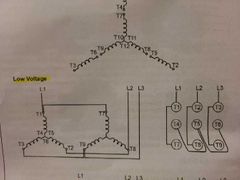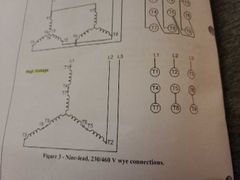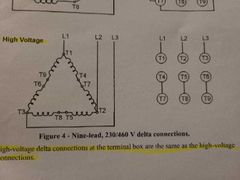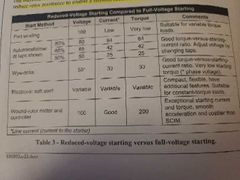![]()
![]()
![]()
Use LEFT and RIGHT arrow keys to navigate between flashcards;
Use UP and DOWN arrow keys to flip the card;
H to show hint;
A reads text to speech;
34 Cards in this Set
- Front
- Back
|
Three-phase multi-lead motors |
Has 3 wires leads brought to the connection Box it is a connection Box, the motor is meant to operate at 1 specific voltage. Many three-phase motors are dual-voltage with 9 leads brought out to the connection Box. They are typically designed to operate on either 240 V or 480 V systems |
|
|
Single-voltage motors |
Has 3 windings or 3 groups of windings. These windings or groups of windings receive a voltage from one of the 3 phase supplied for the system Phase A for one windings or group of windings, phase B for another group/winding and phase C for the final group/windings. |
|
|
Single-voltage motors terminal |
Have terminal designations that indicate polarity. A single voltage motor has Six leads - T1, T2 and T3 brought out to the terminal box - T4, T5 and T6 connections are made in the stator and are not brought out to the connection Box IEC motor use labels U1,V2 and W1 in place of T1, T2 and T3 and U2, V2 and W2 in place of T1, T2 and T3. NEMA have T1, T2 and T3 connected to lines whose phase sequence is L1,L2 and L3 the motor rotation is counter-clockwise when viewed from the not drive end of the motor. If T1, T2 and T3 are connected to L3, L2 and L1 the motor rotation is clockwise. If T1, T2 and T3 are connected to L3, L2 and L1 the motor rotation is clockwise. |
|
|
Dual-Voltage motors |
Dual-voltage three-phase, single-speed motors are labeled 230/460 on the nameplate. The are intended for 240v or 480v systems. Dual-voltage motors gave six windings or groups of windings; two windings or groups for each phase. These windings or groups may be connected in series for 460v or parallel 230v |
|
|
Dual-voltage motor leads for WYE motor |
They have 12 leads.
However only lead T1-T9 are brought out to the connection Box.
Connections T10,T11 and T12 remain in the stator.
|
|
|
Dual-voltage. WYE low voltage connection |

|
|
|
Dual-voltage. WYE high voltage connection |

|
|
|
Dual-voltage motor leads for DELTA motor |
T10, T11 and T12 in a delta motor are permanently connected to T2, T3 and T1 and, as with the wye motor they need nit be brought to the mote connection Box. |
|
|
Dual-voltage. DELTA low voltage connection |

|
|
|
Dual-voltage. DELTA high voltage connection |

|
|
|
Both WYE and DELTA connections |
The winding connections are connected in parallel for low-voltage operation and in series fir high-voltage operation. For the WYE connection these values would be phase values. The phase values would be these values divided by route 3 |
|
|
Motor starters |
Can ether be - across-the-line started that apply full voltage to the motor at start - reduced-voltage starters that provide a reduced voltage at start and full voltage at run. Full-viltage manual and magnetic starts apply full voltage to the motor at the instant of start. They typically produces an initial starting current that is about 500%-600% of the full-load current and starting torque that is about 150% of the full-load torque. Reduced-voltage starters can reduce this inrush current. They also can reduce starting torque which can be a problem if there is too much mechanical load on the motor shaft |
|
|
Across-the-line starters |
Occurs when a starter connects the motor leads directly across the supply Starter may be manual or magnetic starter design |
|
|
Manual and magnetic starter design |
They both connect the motor to the supply by closing switches. The manual motor starter uses a manual open/close switch and the magnetic starter uses an electrically operated switches(condactor). The manual motor is disconnecting mean that manually opens the supply cct. The magnetic motor is not a disconnecting mean because it electrically opens the supply cct. A manual disconnecting means on the line side of the magnetic motor starter in the cct. An overload device I opens the cct when mechanically overloading the motor cause excessive current. |
|
|
Part-winding starters and motors |
A motor capable of part-winding start has two or more set if three-phase windings. If there are two windings pre phase, only one us energized at full voltage to start the motor. Once started, the part-winding starter energizes both windings in parallel to run the motor. If there are three windings, there may be two starting stages before the running stage. |
|
|
Started on only one set of windings |
The impedance is higher and the inrush current to the motor is lower. The inrush of the current is reduced to about 60%-65% of the current that would be occur if both windings were energized at the same time. These types of starter is for loads with small to no load at start. A wye-connected motor with two set of windings is reduced for part-winding start. Six conductors are required between the starter and the motor, they see labelled T1, T2, T3, T7, T8 and T9 |
|
|
Reduced-voltage starters |
Is used when the hugh starting current of a motor can cause excessive voltage drop or voltage sag for the system.
If device drop out due to low voltage, the reduced-voltage starter prevents this by reducing the inrush starting current on a motor cct.
They also can reduce starting torque. Some loads, such as fragile, high inertia load, may be damaged by the sudden imposition of torque on the load.
A correctly selected and set up reduced-voltage starters can give a smoother acceleration than a full-voltage starters. Reduced-voltage starting may require reduced-voltage starter that incorporate timing relays in the control cct.
|
|
|
Timing relays |
Produce the delays necessary to control the length of the starting intervals in the reduced-voltage starter. An on-delay relay, the delay occurs after the relay coil is energized. Is also called time delay on energization (TDOE) An off-delay relay, occurs after the relay coil is de-energized. Is also called time delay on de-energization (TDOD) |
|
|
Timing relays |

|
|
|
Autotransformers starters |
Using different taps on the autotransformers, the voltage to motor can be reduced by specific amounts.
In autotransformers reduced-voltage starting - the starting current to the motor is proportional to starting voltage - the starting current to an autotransformers starter(called the line current) is proportional to the square of the starting voltage - the starting torque is proportional to the square of starting voltage |
|
|
Autotransformers current reductions |
The first reduces motor starting voltage and therefore motor staring current. The second current reduction take place on the line side of the starter by the transformer. |
|
|
Autotransformers starting reduces |
The starting torque of the connected motor to no lower then the reduction of starting current relative to full-voltage starting values. Autotransformers can have, 80%, 65% or 50% taps. With these taps - the starting current to the motor are 80, 65 and 50% of the full-voltage starting current - starting current to the starter, which are called starting line currents, are 64, 42 and 25% of the full-voltage starting current - the starting torque for the 80, 65 and 50% are 64, 42 and 25% of the full-voltage starting torque. |
|
|
Autotransformers starter transition |
Can be open- or closed-transition starters.
Open-transition starters momentarily disconnect the motor from the line during the transition from reduced-voltage starting to full-voltage running.
Closed-transition starters maintain current to the motor through the autotransformers windings during the transition from reduced voltage to full voltage. |
|
|
Open-transition/ closed-transition starters |
Open-transition starter tend to have higher transition current and higher torque(torque bunmp) changes at the end of the transition period. A torque bump is a quick fall and rise of the motors as it is disconnected and reconnected to the starter Closed-transition starters offer better performance. Has a contactor that keeps the motor energized during the transition period. This reduces the current spike and torque bump during transition from start to run. |
|
|
Closed-transition |
Page 16 |
|
|
Wye-delta. connection |
The line voltage is connected across each winding on each phase. VLine is /3 times larger the phase voltage of a wye-connected winding.
The current for a delta connected start is delta line current, which is /3 times the delta-phase current. In WYE connection, the line current is equal to the phase current.
The delta-phase current is /3 times larger then the wye-phase current, and the delta-phase current is /3 times larger than the phase current. -the inrush current Iline in delta /3 ×/3 or 3 times larger the inrush current Iline in WYE - in a WYE start, the inrush line current is only 1/3 of the inrush in delta.
By connecting in WYE to start, the inrush current can be reduced to 33.1/3 %. The starting torque is reduced to 33.1/3 % The Wye-delta starter reduced the inrush to 1/3. Similarly, the starting torque provided by by a Wye-delta starter is one-third that of starting in delta. T start(WYE start)= T start (delta start)/ 3 |
|
|
Wye-delta starting |
Requires a delta motor that has Six terminal available in the terminal box. Three winding or group of windings are connected in WYE for starting, but are recommended in delta for running. |
|
|
Open-transition, Wye-delta starter |
Motor us connected in the delta formation to run, L1 is connected to T1 and T6. L2 is connected to T2 and T4 and L3 is connected to T3 and T5.
The overload devices is only connected to T1, T2 and T3. Only see phase current when the motor is running. The overload setting are based on 57.7% of full-load current. |
|
|
Open-transition, Wye-delta operation |
Page 19 |
|
|
Electronic soft start |
Reduce starting current with a network of electronic switch and programmable chips in printed cct. Once the motor had accelerated, a conventional contactor closes to bypass the electronic switches and apply full voltage to the motor. Are smaller in size then reduced-voltage starters. Provide features not available on magnetic reduced-voltage starters, such as controlling the rate of the current increase during starting for more gradual acceleration. |
|
|
Electronic soft starters modes |
Have two acceleration modes 1- ramp starting, where the starting current is increased at constant rate 2- current-limit starting, where the starter established a maximum current during the starting period Ramp starting increases current and torque during the starting and gradually accelerates most variables torque and constant-torque loads. Current-limit starting restricts the starting current to a maximum value. Some soft starters provide an initial current surge for loads that may require extra torque to overcome the inertia of the load at rest and is sometimes called kick starting . Some combine soft starting with energy savings for light loads, voltage and current decrease to the level the motor requires for the light load |
|
|
Starting a load |
Variables-torque loads which present low counter-torque to the motor at the instant of start are usually easy to start using a reduced-voltage starter. Constant torque load can be different to start with some reduced-voltage starters especially in motors with a NEMA design A or B rotor. These rotor provide a starting torque that is about 150% of the full-load starting torque. A Wye-delta starter on a design B rotor could only supply one-third if the 150% of full-load torque. 1/3 of 150% is 50%, and 50% the full-load torque is insufficient to start a constant-torque load. |
|
|
Comparing reduced-voltage starters |

|
|
|
24 |
24 |

